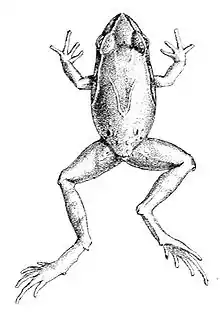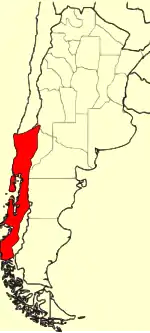Eupsophus calcaratus
Eupsophus calcaratus (common name: Chiloe Island ground frog) is a species of frog in the family Alsodidae. It is endemic to Patagonia (southern Argentina and Chile).[2] It has one of the broadest distributions of any Chilean frog.[3]
| Eupsophus calcaratus | |
|---|---|
 | |
| Scientific classification | |
| Kingdom: | Animalia |
| Phylum: | Chordata |
| Class: | Amphibia |
| Order: | Anura |
| Family: | Alsodidae |
| Genus: | Eupsophus |
| Species: | E. calcaratus |
| Binomial name | |
| Eupsophus calcaratus (Günther, 1881) | |
 | |
| Synonyms | |
|
Cacotus calcaratus Günther, 1881 | |
Description
Eupsophus calcaratus are moderate-sized frogs measuring 31–36 mm (1.2–1.4 in) in snout–vent length. Head is wider than long and snout is rounded. Skin is only slightly granulated but has many spots and reticulated pattern. The colouration is highly variable, but it usually has a characteristic, hourglass-shaped pattern in its head.[4]
The tadpoles develop in water-filled cavities on the ground.[1] Males show parental care: they remain with the eggs and tadpoles. Tadpoles are endotrophic.[4][5]
Habitat and conservation
Its natural habitat is humid Nothofagus temperate forest. It occurs in shady microhabitats (swamps and streams borders).[1]
The species is common in appropriate habitats. Nevertheless, habitat loss and degradation due to deforestation is a major threat, and water pollution caused by forestry work is also a threat.[1]
References
- Carmen Úbeda; Alberto Veloso; Herman Núñez; Néstor Basso (2010). "Eupsophus calcaratus". IUCN Red List of Threatened Species. 2010: e.T57075A11564321. doi:10.2305/IUCN.UK.2010-2.RLTS.T57075A11564321.en.
- Frost, Darrel R. (2014). "Eupsophus calcaratus (Günther, 1881)". Amphibian Species of the World: an Online Reference. Version 6.0. American Museum of Natural History. Retrieved 28 July 2014.
- Nuñez, José J.; Nicole K. Wood; Felipe E. Rabanal; Frank M. Fontanella; Jack W. Sites Jr. (2011). "Amphibian phylogeography in the Antipodes: Refugia and postglacial colonization explain mitochondrial haplotype distribution in the Patagonian frog Eupsophus calcaratus (Cycloramphidae)". Molecular Phylogenetics and Evolution. 58 (2): 343–352. doi:10.1016/j.ympev.2010.11.026. PMID 21145400.
- Javiera Cisternas Tirapegui; Claudio Correa; Marcela Márquez García (2010). "Ficha de especie clasificada. Eupsophus calcaratus (Günther, 1881)" (PDF). Clasificación de especies. Ministerio del Medio Ambiente, Chile. Retrieved 28 July 2014.
- Úbeda, C.; Nuñez, J. (2006). "New parental care behaviours in two telmatobiine genera from temperate Patagonian forests: Batrachyla and Eupsophus (Anura: Leptodactylidae)". Amphibia-Reptilia. 27 (3): 441–444. doi:10.1163/156853806778190015.